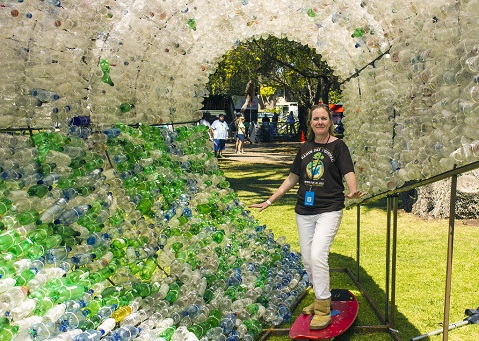Earth Day Matters More than Ever
Contemplate Joy, Despite the Facts

Santa Barbara’s first Earth Day in 1970 was a small but heartfelt affair. It was part of a nationwide day of “Environmental Teach-Ins,” modeled after the antiwar effort. The Environmental Protection Agency did not exist. The Clean Water Act and Clean Air Act did not exist. Recycling was not part of our daily public infrastructure. Even the bakery at the first Santa Barbara festival that offered whole wheat bread – symbolizing the beginnings of a health-food movement – was considered counter-culture.
Now, a generation or two later, Santa Barbara’s Earth Day Festival has changed significantly, as has the landscape around us. Some say we are now in the midst of an extinction crisis – what Elizabeth Kolbert calls the Sixth Extinction. We have crossed the threshold of acceptable levels of greenhouse gases in the atmosphere. Population, climate change, and resource limits are at the root of major systemic stress. It’s been a long time since a scientific study has been released saying that things are looking great.
We have work to do. But, as the poet Wendell Berry says: “Be joyful though you have considered all the facts.” The counter balance to the difficult realities we face is not conjuring up false optimism, but knowing how to stay centered and clear in intention in the face of droughts and polar vortexes and resource conflicts.
The biggest problems of our time aren’t necessarily climate change and human-induced collapse of systems. Those are the symptoms of a world out of balance, of people disconnected from nature and each other. This is why I like to suggest that people take two Earth Days — one to get out into nature, preferably alone or with someone you can be quiet with, leaving behind the twittery technology.
And then, on your second Earth Day, gather. Dance with friends, share a meal with your community. Learn how to grow your own vegetables and save the seeds. Dig out your bike with its splashy tires and bring it to the festival for a tune-up. Think about plastic and how insane it is that we would turn our remaining oil into bottles and bags that we use for five minutes before throwing them away. That is the disconnected world we are going to start stepping away from.
Someone somewhere will drive to Earth Day in a gas guzzler. Some company will try to sell you a product you don’t want; some organization will espouse a doctrine you find too heavy-handed, or not enough. But that’s part of the growth of the movement, isn’t it? Not the hypocrisy or posturing or greenwashing, but the fact that with 7.2 billion people now on the planet, we are negotiating our own definitions of what it means to be “environmentalists,” or of this Earth.
Sigrid Wright is the director of the Santa Barbara Earth Day Festival, which is organized by the Community Environmental Council (CEC). The event will be held Saturday, April 26, 11 a.m.-7 p.m., and Sunday, April 27, 11 a.m.-6 p.m., at Alameda Park. Those interested in hearing more about the history of Santa Barbara’s environmental movement are invited to hear former CEC Executive Director Paul Relis speak on Sunday, April 27, at noon in the CEC booth at Earth Day.



